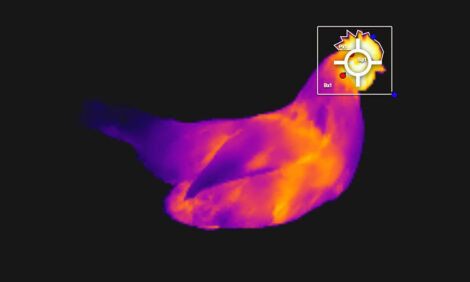



Incubating Eggs at High Altitudes
Steve Tullett, Hatchery Consultant to Aviagen, explains the challenges of hatching chicken eggs at higher altitudes and how to overcome them.Introduction
A hatchery which is located 1,500 metres (4,921 feet) or more above sea level faces some particular challenges. When incubating eggs at high altitudes, slower embryo growth, longer incubation periods and lower hatchability have to be expected. These problems could be solved by building a hatchery that can be pressurised to sea level atmospheric pressure. Partial (and more practical) solutions are possible by good control of egg weight loss and oxygen addition to the setters and hatchers.
What Things are Different at Altitude?
Air always contains about 21 per cent oxygen but at high altitudes (1,500 metres, 4,921 feet, or more above sea level) the air pressure decreases - put simply, there is less air. Less air means there are fewer molecules bumping into each other so all the molecules move around faster. Thus, gases can move through the pores in the eggshell more easily (Table 1). This only partially offsets the shortage of oxygen at high altitudes but it results in eggs losing carbon dioxide and water faster than they would at sea level. The extra loss of carbon dioxide does not appear to affect the embryo.
| Table 1. Gases move through the eggshell faster at altitude | |
|---|---|
| Altitude metres (feet) | Percentage increase in speed with which gases can cross the eggshell compared to sea level |
| 0 | - |
| 500 (1,640) | 6 |
| 1,000 (3,281) | 13 |
| 1,500 (4,921) | 20 |
| 2,000 (6,562) | 27 |
| 2,500 (8,202) | 36 |
| 3,000 (9,842) | 45 |
Thus, the main problems facing chicken embryos when incubated at high altitudes are a reduced oxygen supply and dehydration. As a result, the hatchability of fertile eggs decreases with increasing altitude (Figure 1).

The First Priority: Ensure That Egg Weight Losses Are Correct
The first priority when incubating eggs at high altitudes is to ensure that egg weight losses are correct (see Hatchery How To No.1 for recommendations on optimum egg weight loss). Based on the fact that water diffuses through the pores in the eggshell faster at altitude this would mean running a higher incubator humidity set-point.
Starting with two common incubator humidities at sea level, Table 2 gives the relative humidity set-points that would compensate for the increasing speed of movement of water molecules at higher altitudes.
| Table 2. Relative humidity settings that will give the same egg weight losses at different altitudes | ||
|---|---|---|
| Altitude metres (feet) | If 50% RH used at sea level | If 53% RH used at sea level |
| 0 | 50 | 53 |
| 500 (1,640) | 53 | 56 |
| 1,000 (3,281) | 56 | 58 |
| 1,500 (4,921) | 58 | 61 |
| 2,000 (6,562) | 61 | 63 |
| 2,500 (8,202) | 63 | 65 |
| 3,000 (9,842) | 65 | 67 |
However, there is evidence that chickens reduce their eggshell porosity with increasing altitude. This means the altitude of the breeder flock relative to the altitude of hatchery may influence the best choice of the humidity set-point (Figure 3). Therefore, always be guided by actual egg weight loss in your hatchery, and alter your humidity set-point to achieve the recommended optimum egg weight losses.

Ventilation and Oxygen
It is important to try and maximise oxygen availability to the embryo but to avoid over-ventilating the incubators. Over-ventilating incubators is a potential risk because the incoming air is usually colder and drier at high altitudes and the incubators may find it more difficult to control their temperature and humidity set-points.
Up to 1,500 metres (4,921 feet), only slight losses in hatchability should be experienced, especially if egg weight losses are carefully controlled. Above 1,500 metres (4,921 feet), losses in hatchability have to be expected. Oxygen addition to the setters and hatchers will help increase hatchability, but may not be cost-effective.
Table 3 gives some indications of the oxygen concentrations that are needed at various altitudes to restore the oxygen availability to the embryo to sea level values. Above 2,000 metres (6,562 feet), the level of oxygen addition required to achieve sea level oxygen pressure significantly increases the fire risk. From a safety perspective, levels of more than 25 per cent oxygen are not usually recommended.
| Table 3. Oxygen levels that will give equivalent external oxygen partial pressure at different altitudes. As a safety issue, levels of more than 25% oxygen are not usually recommended. | |
|---|---|
| Altitude metres (feet) | Oxygen % |
| 0 | 20.95 |
| 500 (1,640) | 22.34 |
| 1,000 (3,281) | 23.84 |
| 1,500 (4,921) | 25.47 |
| 2,000 (6,562) | 27.24 |
| 2,500 (8,202) | 29.16 |
| 3,000 (9,842) | 31.24 |

Instead of adding pure oxygen, levels in the incoming air can be increased using an industrial oxygen concentrator (Figure 2). These work by preferential absorption of nitrogen from the pressurized air, which is then vented to the exterior when the pressure is lowered.
Using this technology at 1,900 metres (6,234 feet), it is possible to increase the oxygen concentration of the air to 23 per cent, which will give a three to five per cent hatch lift at relatively low cost.
Eggshell Adaptation at High Altitudes
There are many species of bird that successfully nest above 4,000 metres (13,123 feet). A crucial part of this success appears to be the ability of birds to alter the porosity of the eggshell. With increasing altitude, chickens appear to reduce eggshell porosity in order to offset the potentially excessive water loss from the egg because of the faster movement of the water molecules at altitude.
The potential ability of chickens to alter eggshell porosity presents some opportunities as well as some challenges if the breeder flock is not at the same altitude as the hatchery (see Figure 3).
Conclusion
Incubating eggs at high altitudes (1,500 metres or 4,921 feet or more above sea level) can be challenging, but with better understanding of the principles involved, practical solutions can be found to improve hatchability and chick quality.
July 2013









